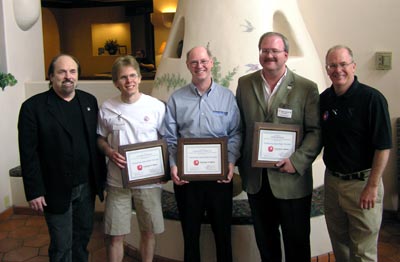Teachers in space, the next generationby Jeff Foust
|
| “We want to take 100 teachers a year into suborbital flight,” said Boland. “We see teachers experiencing spaceflight and returning to the classroom within days.” |
Last month the Space Frontier Foundation formally kicked off its latest project, Teachers in Space, at a pair of conferences: the National Science Teachers Association annual conference in Anaheim and the Space Access ’06 conference in Phoenix. The program’s goal is straightforward: to provide teachers with flights into space on the emerging generation of commercial suborbital spacecraft, with the hope that such flights will inspire teachers and students alike at a time when education, particularly of math and science, has become a subject of much concern in the country.
“Here today we have two national needs that are intersecting and converging,” said Bill Boland, leader of the Teachers in Space program, during a brief presentation about the project April 21 in Phoenix. The first, he said, is that “math and science education in this country is in deep crisis.” The second, he added, “is to provide for the next great economy with cheap access to space.”
Unlike NASA’s original or updated Teacher in Space program, the Foundation’s new effort is looking at flying many more teachers, and cycling them back into the classroom quickly. “We want to take 100 teachers a year into suborbital flight,” said Boland. “We see teachers experiencing spaceflight and returning to the classroom within days.”
The effort had been a pet project for some time of Ed Wright, a Space Frontier Foundation advocate and founder of X-Rocket LLC. Wright went so far as to fly a teacher, Pam Leestma (cousin of NASA astronaut David Leestma), on his company’s MiG-21 jet in March 2005. While the Foundation informally promoted the project at the International Space Development Conference in Washington nearly a year ago, only now is the organization pressing ahead publicly with the project at the two conferences.
At the NSTA conference, Boland said that the effort got an “overwhelmingly positive” response from the teachers in attendance. In addition, the project got 369 signed declarations of interest from teachers. In Phoenix, the project got something even more tangible: agreements from three companies—Armadillo Aerospace, Rocketplane Ltd., and XCOR Aerospace—to fly one teacher each once their suborbital vehicles enter operations.
These “scholarships”, as the Foundation calls them, carry a hefty price tag: between $100,000 and $200,000 each, depending on how much each company values a passenger ticket on its vehicles. Leaders of all three companies, though, seemed more than willing to part with that size of in-kind donation.
“Inspiration is not really an easy thing to measure, but imagine yourself as a kid in school, having your science teacher having actually flown into space,” said John Carmack of Armadillo Aerospace. “None of this is a sure thing—you can’t really guarantee that you’ll inspire a new generation—but it seems like a pretty good step in the right direction.”
“Inspiration always accelerates education, and what history has shown us is that the space program is extremely inspiring,” added George French of Rocketplane.
Jeff Greason said efforts like this could address concerns in both industry and government about a lack of a well-trained high-tech workforce, which he said has been a concern of his dating back to his previous career as a manager at Intel. “There are a lot of people out there who would like to do something about the education problems we’ve got. There’s a smaller but still significant number of people who sense the importance of this industry and want to do something to help. The idea of putting these two things together is magic.”
Despite these scholarship awards, the Teachers in Space project has a lot of work in front of it. Like so many other efforts, the project is looking to the private sector for donations, which it will eventually use to purchase additional suborbital tickets. Later, Boland said that they would look to support from state and federal governments; one possibility he floated in his presentation was some kind of joint effort with the Department of Transportation and Department of Education to promote the program.
| “There are a lot of people out there who would like to do something about the education problems we’ve got,” said XCOR’s Greason. “There’s a smaller but still significant number of people who sense the importance of this industry and want to do something to help. The idea of putting these two things together is magic.” |
The project has also yet to develop the criteria by which it will select teachers to receive those scholarships. Boland said he hopes to eventually develop a “web-based community of teachers” interested in suborbital spaceflight. “We know our job is to keep this group of people excited, and it won’t be an easy job,” he said. To maintain interest, he said they are considering a number of “cool projects” for their teachers like PongSats, the table tennis ball-sized experiments flown to high altitudes on balloons.
There’s also the potential for competition, and not from NASA. Virgin Galactic is rumored to be working on its own teacher-in-space program, which may be announced in the near future. If they do, it would create an interesting conflict: one of the advisors for the Foundation’s Teacher in Space program is Burt Rutan.
The Teacher in Space project, Foundation co-founder Rick Tumlinson admitted, seems a little out of place for an organization known for being a bit radical and picking fights with the bureaucracy. If the Foundation is a group of Old West gunslingers, he said, “This is a case where we holster our Colt .45’s and decide to help a schoolmarm build a schoolhouse.”
